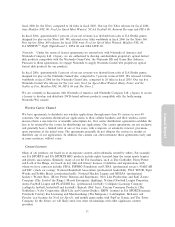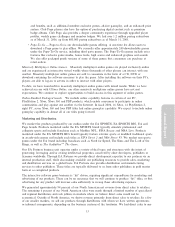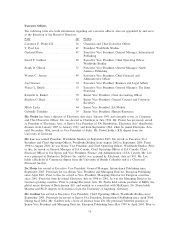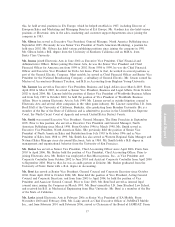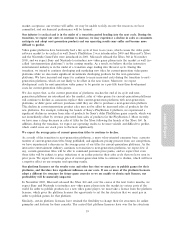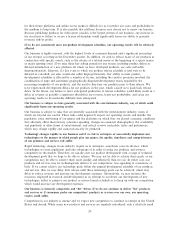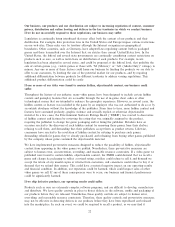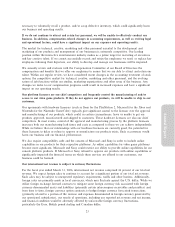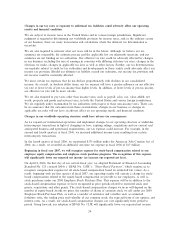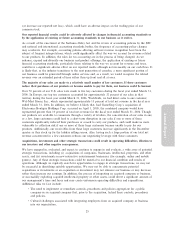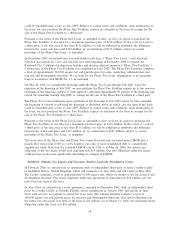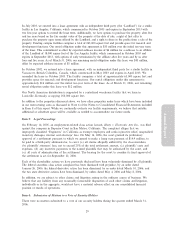Electronic Arts 2006 Annual Report Download - page 91
Download and view the complete annual report
Please find page 91 of the 2006 Electronic Arts annual report below. You can navigate through the pages in the report by either clicking on the pages listed below, or by using the keyword search tool below to find specific information within the annual report.
market acceptance, our revenue will suÅer, we may be unable to fully recover the resources we have
committed, and our Ñnancial performance will be harmed.
Our industry is cyclical and is in the midst of a transition period heading into the next cycle. During the
transition, we expect our costs to continue to increase, we may experience a decline in sales as consumers
anticipate and adopt next-generation products and our operating results may suÅer and become more
diÇcult to predict.
Video game platforms have historically had a life cycle of four to six years, which causes the video game
software market to be cyclical as well. Sony's PlayStation 2 was introduced in 2000 and Microsoft's Xbox
and the Nintendo GameCube were introduced in 2001. Microsoft released the Xbox 360 in November
2005, and we expect Sony and Nintendo to introduce new video game players into the market as well (so-
called ""next-generation platforms'') in the coming months. As a result, we believe that the interactive
entertainment industry is in the midst of a transition stage leading into the next cycle. During this
transition, we intend to continue developing and marketing new titles for current-generation video game
platforms while we also make signiÑcant investments developing products for the next-generation
platforms. We have incurred and expect to continue to incur increased costs during the transition to next-
generation platforms, which are not likely to be oÅset in the near future. Moreover, we expect
development costs for next-generation video games to be greater on a per-title basis than development
costs for current-generation video games.
We also expect that, as the current generation of platforms reaches the end of its cycle and next-
generation platforms are introduced into the market, sales of video games for current-generation platforms
will continue to decline as consumers replace their current-generation platforms with next-generation
platforms, or defer game software purchases until they are able to purchase a next-generation platform.
This decline in current-generation product sales may not be oÅset by increased sales of products for the
new platforms. For example, following the launch of Sony's PlayStation 2 platform, we experienced a
signiÑcant decline in revenue from sales of products for Sony's older PlayStation game console, which was
not immediately oÅset by revenue generated from sales of products for the PlayStation 2. More recently,
we have seen a sharp decrease in sales of titles for the Xbox following the launch of the Xbox 360. In
addition, during the transition, we expect our operating results to be more volatile and diÇcult to predict,
which could cause our stock price to Öuctuate signiÑcantly.
We expect the average price of current-generation titles to continue to decline.
As a result of the transition to next-generation platforms, a more value-oriented consumer base, a greater
number of current-generation titles being published, and signiÑcant pricing pressure from our competitors,
we have experienced a decrease in the average price of our titles for current-generation platforms. As the
Annual Report
interactive entertainment industry continues to transition to next-generation platforms, we expect few, if
any, current-generation titles will be able to command premium price points, and we expect that even
these titles will be subject to price reductions at an earlier point in their sales cycle than we have seen in
prior years. We expect the average price of current-generation titles to continue to decline, which will have
a negative eÅect on our margins and operating results.
Our platform licensors set the royalty rates and other fees that we must pay to publish games for their
platforms, and therefore have signiÑcant inÖuence on our costs. If one or more of the platform licensors
adopt a diÅerent fee structure for future game consoles or we are unable to obtain such licenses, our
proÑtability will be materially impacted.
In November 2005, Microsoft released the Xbox 360 and, over the course of the next twelve months, we
expect Sony and Nintendo to introduce new video game players into the market in various parts of the
world. In order to publish products for a new video game player, we must take a license from the platform
licensor, which gives the platform licensor the opportunity to set the fee structure that we must pay in
order to publish games for that platform.
Similarly, certain platform licensors have retained the Öexibility to change their fee structures for online
gameplay and features for their consoles. The control that platform licensors have over the fee structures
19




